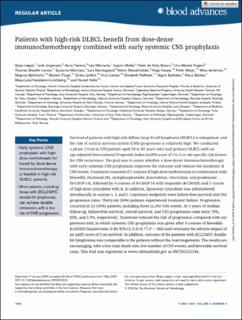Patients with high-risk DLBCL benefit from dose-dense immunochemotherapy combined with early systemic CNS prophylaxis
| dc.contributor.author | Leppä, Sirpa | |
| dc.contributor.author | Jørgensen, Judit | |
| dc.contributor.author | Tierens, Anne | |
| dc.contributor.author | Meriranta, Leo | |
| dc.contributor.author | Østlie, Ingunn | |
| dc.contributor.author | Brown, Peter de Nully | |
| dc.contributor.author | Fagerli, Unn-Merete | |
| dc.contributor.author | Larsen, Thomas Stauffer | |
| dc.contributor.author | Mannisto, Susanna | |
| dc.contributor.author | Munksgaard, Lars | |
| dc.contributor.author | Maisenhölder, Martin | |
| dc.contributor.author | Vasala, Kaija | |
| dc.contributor.author | Meyer, Peter Albert | |
| dc.contributor.author | Jerkeman, Mats | |
| dc.contributor.author | Björkholm, Magnus | |
| dc.contributor.author | Fluge, Øystein | |
| dc.contributor.author | Jyrkkiö, Sirkku | |
| dc.contributor.author | Liestøl, Knut | |
| dc.contributor.author | Ralfkiaer, Elisabeth | |
| dc.contributor.author | Spetalen, Signe | |
| dc.contributor.author | Beiske, Klaus | |
| dc.contributor.author | Karjalainen-Lindsberg, Marja-Liisa | |
| dc.contributor.author | Holte, Harald | |
| dc.date.accessioned | 2022-11-10T15:12:02Z | |
| dc.date.available | 2022-11-10T15:12:02Z | |
| dc.date.created | 2021-02-17T11:30:09Z | |
| dc.date.issued | 2020 | |
| dc.identifier.citation | Blood Advances. 2020, 4 (9), 1906-1915. | en_US |
| dc.identifier.issn | 2473-9529 | |
| dc.identifier.uri | https://hdl.handle.net/11250/3031260 | |
| dc.description.abstract | Survival of patients with high-risk diffuse large B-cell lymphoma (DLBCL) is suboptimal, and the risk of central nervous system (CNS) progression is relatively high. We conducted a phase 2 trial in 139 patients aged 18 to 64 years who had primary DLBCL with an age-adjusted International Prognostic Index (aaIPI) score of 2 to 3 or site-specific risk factors for CNS recurrence. The goal was to assess whether a dose-dense immunochemotherapy with early systemic CNS prophylaxis improves the outcome and reduces the incidence of CNS events. Treatment consisted of 2 courses of high-dose methotrexate in combination with biweekly rituximab (R), cyclophosphamide, doxorubicin, vincristine, and prednisone (R-CHOP-14), followed by 4 courses of R-CHOP-14 with etoposide (R-CHOEP) and 1 course of high-dose cytarabine with R. In addition, liposomal cytarabine was administered intrathecally at courses 1, 3, and 5. Coprimary endpoints were failure-free survival and CNS progression rates. Thirty-six (26%) patients experienced treatment failure. Progression occurred in 23 (16%) patients, including three (2.2%) CNS events. At 5 years of median follow-up, failure-free survival, overall survival, and CNS progression rates were 74%, 83%, and 2.3%, respectively. Treatment reduced the risk of progression compared with our previous trial, in which systemic CNS prophylaxis was given after 6 courses of biweekly R-CHOEP (hazard ratio, 0.49; 95% CI, 0.31-0.77; P = .002) and overcame the adverse impact of an aaIPI score of 3 on survival. In addition, outcome of the patients with BCL2/MYC double-hit lymphomas was comparable to the patients without the rearrangements. The results are encouraging, with a low toxic death rate, low number of CNS events, and favorable survival rates. This trial was registered at www.clinicaltrials.gov as #NCT01325194. | en_US |
| dc.language.iso | eng | en_US |
| dc.publisher | American Society of Hematology | en_US |
| dc.title | Patients with high-risk DLBCL benefit from dose-dense immunochemotherapy combined with early systemic CNS prophylaxis | en_US |
| dc.type | Peer reviewed | en_US |
| dc.type | Journal article | en_US |
| dc.description.version | publishedVersion | en_US |
| dc.rights.holder | © 2020 by The American Society of Hematology | en_US |
| dc.source.pagenumber | 1906-1915 | en_US |
| dc.source.volume | 4 | en_US |
| dc.source.journal | Blood Advances | en_US |
| dc.source.issue | 9 | en_US |
| dc.identifier.doi | 10.1182/bloodadvances.2020001518 | |
| dc.identifier.cristin | 1890786 | |
| cristin.ispublished | true | |
| cristin.fulltext | original | |
| cristin.qualitycode | 1 |
